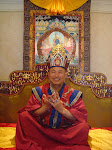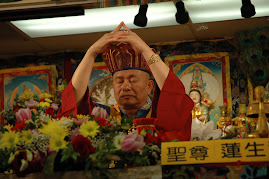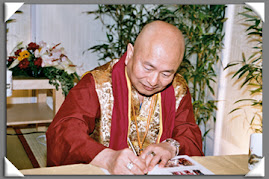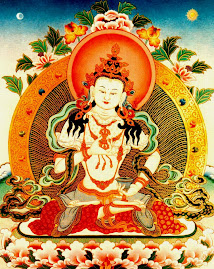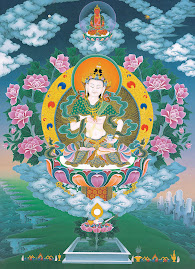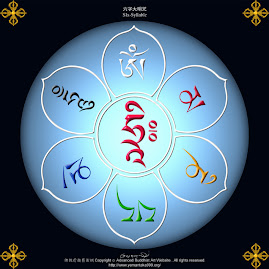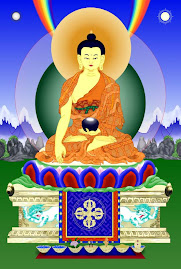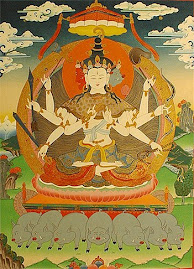A COMPLETE AND DETAILED EXPOSTION ON THE TRUE BUDDHA TANTRIC DHARMA
Written by Living Buddha Lian-sheng, Sheng-yen Lu
After invocation, we then proceed to the third step. What is the third step? Ordinarily, one does the Great Homage as the third step, followed by the Mandala Offering, and the Fourfold Refuge, in this order. However, there are some people who will recite the Fourfold Refuge Mantra or do the Mandala Offering right after the invocation. The sequence of these three rituals is however flexible. Tantric practice, the whole liturgy can be divided into three parts: the Prologue, the Main Body, and the Epilogue. The Great Homage, Mandala Offering, and Fourfold Refuge are part of the Prologue and I remember that, in the past, I used to teach them in the order of Great Homage, Fourfold Refuge, and Mandala Offering. Sometimes people start out with the Mandala Offering, feeling that, since the divine beings have descended following one's invocation of them, one might as well make offerings to them right away. As long as one has a reason for doing these rituals in a certain sequence, it will be all right. Just make sure that one does not miss any of the steps. Though actually, even if a step is missed, there are remedies for it. The Hundred Syllable Mantra is, for example, such a remedy.
The Hundred Syllable Mantra
The Hundred Syllable Mantra of Vajrasattva is a very great mantra because it has three significant meanings. First, it serves as a repentance mantra. Why is this a repentance mantra? Because this mantra teaches one to see into the nonessentiality of all things in the phenomenal world. Inherent in the Hundred Syllable is the meaning of Emptiness, as vast as the Void. Therefore, when one recites the Hundred Syllable Mantra and repents, one can transmute the transgressions committed through the body, mind, and speech into Emptiness.
Second, the chanting of the mantra results in blessings from the Five Dhyani Buddhas. Vajrasattva is the Sixth Vajradhara, a manifestation of the sum total of the Five Dhyani Buddhas or Vajradharas. That is why chanting the Vajrasattva mantra is equivalent to receiving blessings from the Five Dhyani Buddhas.
Third, as I have just explained, this mantra can serve to transmute all errors into Emptiness. Therefore, any mistakes, transgressions, and obscurations which occur during the practice, such as insincerity, vague visualization, idle thoughts, unkind thoughts, or the unintentional skipping of a certain step (e.g. forgetting to do the Mandala Offering) can be remedies by chanting the Hundred Syllable Mantra at the end of the practice.
Therefore, the Hundred Syllable Mantra serves three purposes: 1) repentance; 2) bestowal of blessings from the Five Dhyani Buddhas; 3) the remedy of all oversights and errors.
The Mudras for Great Homage
Next I will discuss with you the third step, which is the Great Homage. In Tibetan Tantric Buddhism, one customarily prostrates completely on the floor and this is considered a form of sincere devotion. After joining the palms together, one touches the crown, then sometimes the back of the head, and then the throat and heart before prostrating on the floor. Tibetans usually just join their palms together and rarely employ other mudras in doing prostrations. So, where do our prostration mudras, such as the Shrine Mudra, Lotus Mudra, and Vajra Handclasp Mudra, come from? These mudras belong to the Tien-tai Esoteric Sect and the Eastern Esoteric School [the Shingon Sect of Japan]. Tibetans do have their own mudras, but these are less widely used. The Japanese Esoteric Schools, compared to the Tibetan Esoteric Schools, sue more mudras in their practice. Our True Buddha School mudras that are used to pay homage to the Buddhas, Bodhisattvas, and Vajra Protectors come from the Eastern Esoteric School.
Since we start our practice sitting down, it would be very interruptive to get up at this point to do a physical prostration. This is why we remain seated from beginning to end, until a complete set of the True Buddha practice is finished.
The Visualized Great Homage is my creation. Other people would get up at this point to do a physical prostration, but I feel that remaining seated provides greater continuity. Also, when we are doing group practice, a limited space can accommodate more people if actual physical prostration is not carried out. Based on these factors, I created the Visualized Great Homage.
Why do some Tibetans touch the back of their heads with their hands while performing prostrations? It has to do with Chi Kung. The human brain is covered by the skull except at the back and at the temples. Touching the temples does not directly exercise the brain. At the back of the neck near the base of the brain is the cerebellum which regulates the circulation of chi in one body. You might not be aware of this, nor have I taught you to do this in the past.
Descending of Divine Beings to Teach Chi Kung
Lately, when I practice Chi Kung to do inner healing for my internal organs, I have been shown to touch this spot. [Grand Master touches the back of this neck] At first I could not figure out why. I thought that touching here at the brow-point was being very reverential to the divine beings; how strange it was to touch the back! Why were they teaching me to do this?
Now, each day after I finish my writing assignment, I set aside a time to do Chi Kung. At the beginning of my exercise, I invoke as follows: "Namo the Primordial Great Western Golden Mother, Namo Amitabha of Sukhavati, Namo Ksitigarbha Bodhisattva, the ruler of the Nether World." Of course, this invocation is done in Taiwanese, and not in Mandarin. It is like this in Taiwanese, don't laugh at me! I invoke them to descend to my Chi Kung practice. I just chant their names very quietly, like this, and in an instant, their frequencies and my frequency make a connection and they come very quickly. I very sincerely sing out the invocations, which are words from my heart, and they come very rapidly.
What happened was, as soon as they divine beings arrived and I joined my two palms together, my hands would be maneuvered to press against the back of my head. When I asked for an explanation, one divine beings told me that this particular area of the body correlates with regulation of the internal organs. With stimulation to certain spots at this area, certain organs will become rejuvenated and will return to their normal functions. Very soon, one becomes "thirty-something" again and newly invigorated! So it turns out that stimulation at this area can have many advantages. No wonder the Tibetans hit themselves here! I had not thought of this before and that is why I have not taught you to touch here at the back of the head. I was afraid that you might hit it too hard and break your neck! [audience laughter] This is what I have learned. The divine beings, Golden Mother of the Primordial Pond, Amitabha, and Ksitigarbha Bodhisattva, taught me that this is a secret to longevity.
After touching here at the back, one goes on to touch the crown and visualize the white beam of light here. Remember at this point, the Personal Deity has been invoked and is now sitting in the Empty Space above, facing one. As one touches here, the white light from the forehead of the Personal Deity will shine on one's forehead. Next, one touches the throat and visualizes red light entering one's throat. Then one touches the heart and visualizes a blue light entering the heart. This is followed by the release of the mudra. It is the same with paying homage to the Bodhisattvas and Vajra Protectors - one follows the same sequence of white light, red light, blue light, and release of mudra. Then the Half Bow is performed. All these are done with visualization. When the three lights are shining on one, one also has to visualize oneself prostrating on the floor, then getting up before releasing the mudra. This visualization step is very important.
Throughout this process, when the Personal Deity radiates light on one and one takes this light in, the phenomenon of mmersion?occurs. What is "immersion"? It is actually the shining and entering of light into one body. If, however, one is like a steel plate which does not absorb much light and reflects most of the light away, then there is no immersion. By visualization of the light, one is purifying the body, speech, and mind. When the white light shines on one, one should feel as if a lamp is shining on one, and one becomes saturated with the white light. It is the same with the red and blue lights: one whole body is completely immersed in that particular light. This is the visualization that accompanies the Great Homage.
Invocation of the Three Main Deities
Someone asked me, "Grand Master, why do you invoke the Golden Mother of the Primordial Pond, Amitabha, and Ksitigarbha Bodhisattva everytime you do an invocation? Can we also follow your example and invoke them?" I can make a rule to govern whom one should invoke, I only know why I always invoke these three deities. I learned, at the beginning of my practice, that these three divine beings are the Principal Rulers in the spiritual realms.
The Golden Mother of the Primordial Pond is a Ruler of the Immortals, and her Primordial Pond at Mount Kunlun is an assembly place for the immortal beings. As a ruler of the immortal beings, the Golden Mother of the Primordial Pond has existed form the beginning.
I consider Amitabha Buddha the King of Buddhas. Why? Because, whether one practices exoteric or esoteric Buddhism, Amitabha is the Buddha who extends the widest salvation. In China and Southeast Asia, every Buddhist monks chant Amitabha's name; the Taoists also chant his name. The Taoists chant the name of the Immeasurable Life Buddha, which is another epithet for Amitabha. Amitabha is also known as the Immeasurable Light Buddha and the Transcendent Sun Moon Lamp Buddha. That is why Amitabha Buddha provides the greatest salvation. The other four Dhyani Buddhas give salvation, too, but Amitabha vows are the most encompassing. That is why he is the King of Buddhas.
Although Ksitigarbha Bodhisattva is referred to as the Ruler of the Nether World, he does not only save beings lost there. He also aids beings in all six realms, including devas, humans, asuras, hell inhabitants, hungry ghosts, and animals. In fact, it is because he has expanded his salvation to the realms of hells, hungry ghosts, and animals that he is reverently referred to as the King of the Nether World.
Because of my own vows and my initiation into spiritual cultivation by the Golden Mother of the Primordial Pond, I feel indebted to the kindness of the Ruler of the Immortals. How can I forget the graces she has bestowed on me? I cannot sever my ties to her just because I have become a Buddhist. As a human being, one has to remember the kindness and favors bestowed upon one. "One cannot ignore the traces on the surface after a boat cuts through the water, nore should one throw away the walking stick after crossing the bridge." That is why, in my invocation, the Golden Mother of the Primordial Pond is always the first deity I call upon. Whether or not one wants to call upon the Golden Mother of the Primordial Pond first is a personal choice. And I always invoke Amitabha next and then the Ksitigarba Bodhisattva. In fact, there is a very subtle connection between my invocation of the Ksitigarbha Bodisattva and his coming to teach me this mudra (touching the back of my head during the practice of the Chi Kung).
Guidance of the Thousand-armed Thousand-eyed Kuan Yin Bodhisattva
Recently I have been diligently practicing the Chi Kung every day. Many different divine beings, including the Thousand-armed Thousand-eyed Kuan Yin Bodhisattva, have come to teach me steps that are made up of variety of very unusual postures. Each of these postures corresponds to the adjustment of an internal organ. For example, this posture regulates one spleen, this posture regulates one's kidneys, this one regulates the heart while this one regulates the liver. In the future, I shall create a set of Fist Exercises called the Internal Organs Fist Exercises [audience laughter] which will consist of a set of movements to help strengthen the chi. When the strengthened chi circulates throughout the body, it will open up blockages, stimulate the organs' functions, and prevent degeneration.
These are what the Internal Organs Fist Exercises can do. This kind of Chi Kung exercise should always have been in existence; perhaps it was lost in the past. When a cultivator reaches a certain level of spiritual maturity, he or she will have access to this kind of knowledge. Although I had not encountered this practice before, the Thousand-armed Thousand-eyed Kuan Yin Bodhisattva, Cundi Bodhisattva, Yamantaka, and Trailokya-vijaya-raja came, each teaching me a different posture. Well, the postures they taught me were quite remarkable! How should I describe them? Like the "rhinoceros admires the moon? It is like this! [audience laughter] The whole body reclines at an angle, while the head turns under and backward like this. There is also a posture called the Immortal Pointing the Road and another called the White Snake Spitting. There are many kinds of postures!
Everytime the Thousand-armed Thousand-eyed Kuan Yin comes, he asks me to extend my arms like this. Then he demonstrates with his thousand arms how to raise my arms, this way, to the highest. Then he shows me how to "lower" them, how to "raise" them, how to "sustain" them, and how to "release" them. This is a very mysterious exercise. These kinds of body movements, like a language, can be translated into the exercise of the chi. Isn't body language a popular term nowa-days? So the Bodhisattva first teaches me the body movements, then he further teaches me what these movements are accomplishing. In fact, it is all an exercise for strengthening the chi, opening up the channels and meridians, and sustaining the light drops. It has to do completely with the Yoga of Energy.
Great Homage Visualization
The Great Homage also requires certain skills. When Tibetans perform the Great Homage, they touch the back of their heads. This is followed by the visualization of the white, red, and blue lights. The actual prostration comes next. This is also a way of strengthening the body. Are there any other visualizations besides the white, red and blue lights? Of course, there are. In general, the exoteric schools practice the Great Homage while facing the shrine, and without doing any visualization. In Tantric or esoteric schools, visualization is required. I once wrote a verse about the Great Homage which described how, in this ritual, one is paying universal homage to all beings. Besides very clearly visualizing the Golden Mother of the Primordial Pond, Amitabha, and Ksitigarbha Bodhisattva appearing in the front, one also has to visualize all Buddhas in the Ten Directions and Three Times and all Bodhisattvas and Mahasattvas in the Universe appearing in the background.
How is this visualization done? Many people have asked this question. How can one visualize all the Buddhas and Bodhisattvas appearing in front of one? How can one ever finish visualizing? Of course, one can never finish visualizing all the divine beings in the Universe. Many people can't even successfully visualize one single Buddha. Perhaps after half a day of visualization, the ears are still missing. Sometimes after visualizing the head, the body is gone. Sometimes after visualizing the clothes, the head disappears. Some people just have a very difficult time in doing the visualization.
The Detailed Visualization
Actually there is a method to do detailed visualization: one first visualizes the brows, then the eyes, nose, mouth, ears, shape of head, the body, the limbs, and the celestial garments. Then, as soon as the visualization is done, let it disappear. The image does not need to be fixed in the mind and not allowed to disappear. This isn't the answer at all. When I visualize Amitabha, he immediately appears. Standing on a lotus, he wears a very wonderful celestial garment, his ears are very long, and on top of his head is the crown protrusion. One of his hands holds the Wish Bestowing Mudra, and the other holds a lotus. As soon as one finishes clearly visualizing all this, one may immediately release the image and let it disappear. After practicing for a long time one will find that, as soon as one focuses one's attention, the Buddha immediately and vividly appears in front. This takes a long time to perfect. In the beginning, even I was not able to produce such a vivid image of the Buddha.
For example, this morning at the True Buddha Tantric Quarter, I was making an outdoor offering at the external shrine - some people actually witnessed this - I noticed that several people were turning their heads to look at me. I had visualized myself transforming into Amitabha, a very tall and golden Amitabha who reached all the way up to the clouds. I also visualized the sweet nectar I was holding transforming into millions of drops of sweet nectar that filled up all spaces. I was using the detailed method of visualization. Even as I am talking to you now, I can achieve a very vivid visualization. Remember, however, one is not required to continue visualizing the image for an extended period of time. It is not necessary to continually visualize Amitabha in the same spot forever!
An All - Encompassing Great Homage
How does one visualize all the Buddhas in the past, present, future, and in the Ten Directions? One uses the image of star lights. For example, one visualizes the Principal Deity at the front, and behind is a boundless expanse of twinkling stars. This is a way to pay universal homage to all Buddhas, Bodhisattvas and Mahasattvas in all dimensions. In performing the Great Homage, one immediately visualizes the stars and the Principal Deity in front of the stars, and then proceeds to visualize oneself bowing to the Buddhas. This visualization will produce great merits. During this third step of the Great Homage, by using this visualization, one is paying an all-encompassing homage to all Buddhas in the Universe.
In general, the exoteric schools do not have this kind of visualization when they do prostration, nor do they visualize the blessing of lights. This is a technique found only in the esoteric schools. Merits generated by this kind of all-encompassing Tantric homage is very great. In the exoteric schools, one prostrates to just one Buddha or several Buddhas at a time, while in the esoteric schools, one prostrates to trillions of Buddhas at one time. One all-encompassing great homage in Tantrayana is equivalent to several years of prostrations in Sutrayana. That is why Tantric cultivation can enable one to achieve Buddhahood in this life, whereas the exoteric schools teach that one can only attain Buddhahood in the future, three great kalpas away. It is possible to attain Buddhahood in this life through Tantra because inherent in Tantra is the supreme wisdom, supreme methods, supreme liturgy which brings about transcendental accomplishments. Simply put, the Great Homage in Tantrayana is a method of paying an all-encompassing homage with one single prostration.
The Tantric rite of homa (fire offering) also accomplishes great merits. In the Sutric schools, one lights one or three incense at a time whereas, in the Tantric fire offerings, one burns tens of thousands of incenses at one time. The offering of incense in one Tantric fire puja is equivalent to several years worth of incense offering in the Sutric schools. Fire offering is not found in Sutric schools, only in Tantra. The Tantric fire offering is one of the greatest offerings one can make to generate merits and spiritual accomplishment.
A Sincere Prostration - Repentance
Inherent in one Tantric Great Homage prostration is tens of thousands of prostrations. One must not underestimate this ritual of the Great Homage, as it completely teaches one how to subjugate both one's ego and pride. By prostrating in front of the Buddhas and Bodhisattvas, one repents and submits one's body, mind, and speech completely to the Buddhas and the Personal Deity. One prostration is all prostrations. In one prostration, one pays homage to all Buddhas. This is a unique ritual in Tantra and its merits are truly great, so one should not slight it.
During group practices, many people do the Great Homage like this, very quickly. [Grand Master demonstrates to audience laughter] There is hardly any energy involved in it; also it does not look very dignified. One has to know that dignity has to come from within, from the heart. One uses visualization to create this sense of grandeur and dignity. Some people might superficially feel that, after participating in a couple group practices, they are able to learn all the steps, including how to form the mudras. It seems so easy and simple. Little do they know there is a great art involved in it!
That is why a detailed exposition of the practice is necessary. With this knowledge, one learns to appreciate the profundity of the Tantric Dharma and, therefore, to go beyond a superficial involvement with it. During group practices, some people finish very quickly; the whole session may take only twenty minutes. If one asks them if they have acquired any expansion of awareness or perceptions during the practice, they reply, "No, but who cares as long as I have done all the steps? Grand Master asked me to do two hundred sessions of the practice, and I am able to do several sessions in one day. [audience laughter] Pretty soon, they will be all done. But, how come I still have so many problems? How come my impediments are still so great?" [audience laughter] Of course, their obscurations would still be great! They have not really immersed themselves into the practice, and they have not ennobled their hearts and minds during the process. The Great Homage is a very dignified event wherein one engenders a noble state of mind to pay homage to all the Buddhas and Bodhisattvas in the universe. The Buddhas and Bodhisattvas are very majestic and noble. The Supreme Consciousness of the Universe is extremely great and lofty. When one repents and humbles oneself by paying homage to the Universal Consciousness, one is striving towards spiritual maturity. This is not a casual step to be done perfunctorily.
Therefore, I hope all of you will have a tacit understanding of this third step, the Great Homage. That is also why each of the Four Preliminary Practices - the Fourfold Refuge, the Great Homage, the Mandala Offering, and the Vajrasattva Practice - is a separate practice on its own. Just give this some thought: why is it necessary to set aside a separate time to practice the Great Homage? The merits generated are infinitely great! Every day, before one begins meditation practice, one should do the Great Homage. Physically it strengthens one's body, while spiritually it induces a reverent devotion. At the same time, the lights of the trillions of Buddhas and Bodhisattvas will shine on one, and one will be completely moved by this kind of blessing. Compared to ordinary prostrations, a Great Homage accompanied by this kind of visualization gives very different results.
While doing the Great Homage, one can transcend the ego if one is able to completely let go of the body and mind to receive and hold the lights from the trillions of Buddhas and Bodhisattvas. By accepting the light shining on one and the grace of the Buddhas and Bodhisattvas, one willingly releases all the negative energy and transgressions one has committed. Only a Great Homage performed in this fashion is this excellent and can generate such vast power.
Today I have talked about the first three steps in the True Buddha Dharma Practice. Tomorrow we will pick up from here and continue, so that the whole liturgy will be covered in the next several days. What do you think?









